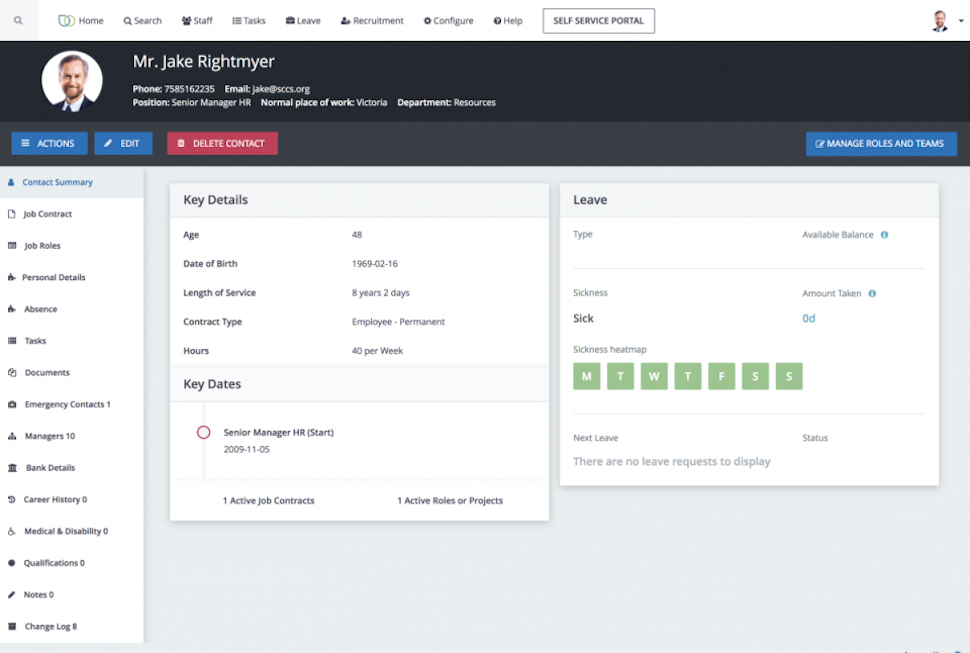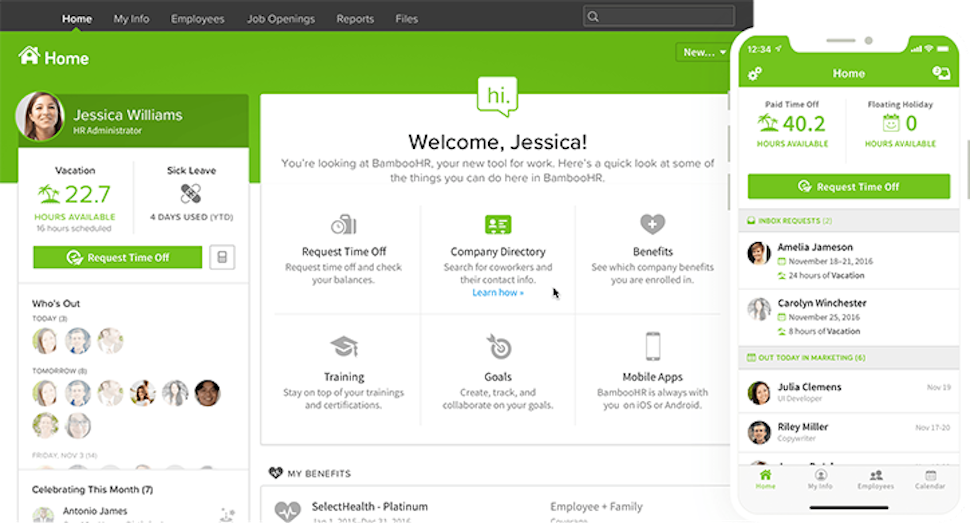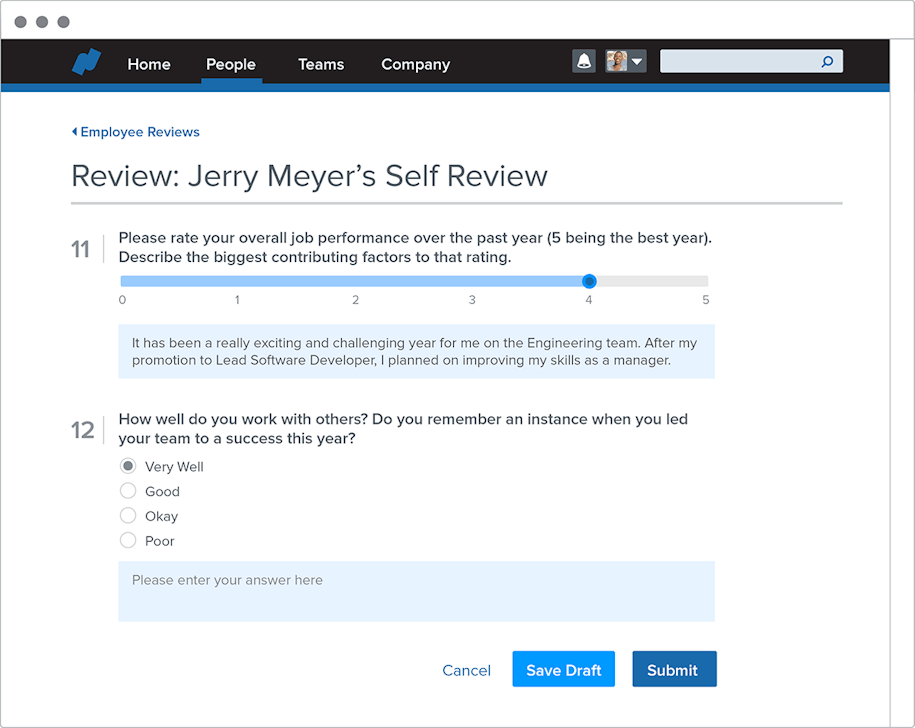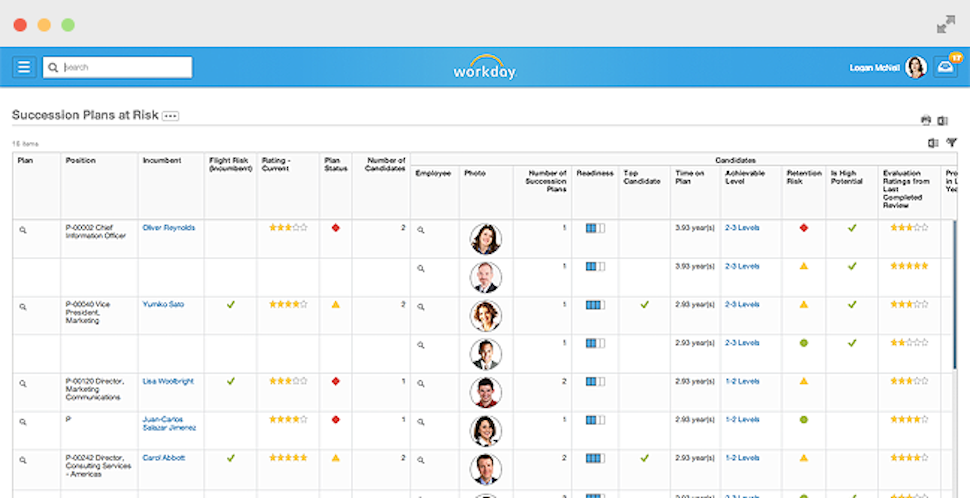Find the best HR Software for Nonprofits
Compare Products
Showing 1 - 20 of 598 products
Sort by
Reviews: Sorts listings by the number of user reviews we have published, greatest to least.
Sponsored: Sorts listings by software vendors running active bidding campaigns, from the highest to lowest bid. Vendors who have paid for placement have a ‘Visit Website’ button, whereas unpaid vendors have a ‘Learn More’ button.
Avg Rating: Sorts listings by overall star rating based on user reviews, highest to lowest.
A to Z: Sorts listings by product name from A to Z.
Vista
Vista
PDS’ Vista is the complete HCM software solution for organizations with employees based in the United States, Canada, or the Caribbean. All the pieces—recruiting, onboarding, human resources, benefits, payroll, time and attendance...Read more about Vista
NuView
NuView
NuView is a human resource management system that aims to streamline HR processes and enhance visibility across HR managers, employees, and senior leadership. It brings together all HR data in a single unified platform, allowing f...Read more about NuView
iCIMS Talent Cloud
iCIMS Talent Cloud
Support the entire candidate experience from start to finish with a unified recruitment platform. iCIMS offers best-in-class recruiting products for your hiring life cycle, available as part of one unified talent cloud platform, o...Read more about iCIMS Talent Cloud
AcquireTM
AcquireTM
AcquireTM Applicant Tracking Software is a cloud-based talent management and recruiting solution designed to meet the hiring requirements of small and midsize businesses. It provides a holistic, 360-degree view of hiring processes...Read more about AcquireTM
PCRecruiter
PCRecruiter
PCRecruiter is an ATS/CRM hybrid SaaS solution for recruiting and sourcing professionals in executive search agencies, contract placement firms, and HR teams across a wide array of sizes and markets. PCRecruiter offers a comprehen...Read more about PCRecruiter
ApplicantStack
ApplicantStack
An applicant tracking system is the foundation of strategic talent management. ApplicantStack capably empowers all stakeholders: internal recruiters, hiring managers, administrators and—most importantly—applicants. ApplicantStack ...Read more about ApplicantStack
Small Improvements
Small Improvements
Small Improvements is a cloud-based platform that enables users to administer and manage performance reviews and feedback as well as utilize 360-degree, continuous feedback. It can be used by small to midsize businesses in a numbe...Read more about Small Improvements
BambooHR
BambooHR
Instead of using fragmented spreadsheets, limited or clunky software, and physical paper, BambooHR helps you centralize your data and automate the way you complete key HR tasks. As you hire, onboard, and pay your employees, every ...Read more about BambooHR
iRecruit
iRecruit
iRecruit is a cloud-based Human Resource Management(HRM) solution that helps businesses to track applicants and manage the onboarding process for new recruits electronically. The solution gives HR departments, recruiters and hirin...Read more about iRecruit
JazzHR
JazzHR
JazzHR is a Software-as-a-Service (SaaS) applicant tracking system. Founded in 2009, JazzHR provides recruiting and hiring software accessible to businesses of all sizes. JazzHR’s sourcing tools enable users to post jobs, mir...Read more about JazzHR
ApplicantPRO
ApplicantPRO
ApplicantPRO by JobMatch is a cloud-based applicant tracking (ATS) system designed for small to midsized companies that are working to stay in compliance with EEO/AA and OFCCP guidelines.. Its interface can be utilized by organiza...Read more about ApplicantPRO
Oracle Taleo Cloud
Oracle Taleo Cloud
Oracle Taleo Cloud is a cloud-based human resource (HR) management suite suitable for large and midsize businesses in all industries. Key features include candidate management and employee onboarding, especially for high volumes o...Read more about Oracle Taleo Cloud
eTOTALplan
eTOTALplan
eTOTALplan is a cloud-based employee scheduling solution that helps to manage and track employees. The solution caters to different industries such as government, restaurants and charitable organizations. Key features include work...Read more about eTOTALplan
HRweb
HRweb
hrweb.com, the maker of HRweb, offers employee information tracking, attendance, performance reviews or employee appraisals, self or 360 reviews, recruiting with applicant interface, training and more. HRweb helps organizations ef...Read more about HRweb
Pilat HR
Pilat HR
Pilat is a cloud-based human resource management (HRM) solution that assists HR managers to evaluate employee performance. The solution caters to businesses across industries such as real-estate, manufacturing, energy, logistics a...Read more about Pilat HR
OrangeHRM
OrangeHRM
Revolutionize Your HR Processes with OrangeHRM! Say goodbye to the hassle of managing your workforce manually. OrangeHRM provides a scalable HRM solution for small and midsize businesses, ensuring the entire employment lifecycle ...Read more about OrangeHRM
myStaffingPro
myStaffingPro
myStaffingPro is a web-based Applicant Tracking System (ATS) that offers applicant tracking, candidate recruiting, and on boarding in a scalable, and configurable solution. The application is SaaS based and makes it accessible fro...Read more about myStaffingPro
emPerform
emPerform
emPerform is a hybrid employee performance management solution that helps organizations to automate performance reviews and align, develop and retain talent. It can be deployed either on-premise or in the cloud. emPerform helps ...Read more about emPerform
HiringThing
HiringThing
We're HiringThing, an applicant tracking solution designed to deliver Hiring Happiness for all. Our feature-rich software allows your company to attract top talent, automate recruiting workflows, and collaborate with the entire hi...Read more about HiringThing
Kapta
Kapta
Kapta Systems offers a cloud-based performance management solution for smaller companies that includes tools for performance reviews, goal management and coaching. Kapta Performance Management Systems allows users to manage t...Read more about Kapta
Popular Comparisons
Buyers Guide
Last Updated: March 16, 2023When running a nonprofit, managing the human resources (HR) aspect of your organization is often a huge challenge. You have to deal with full- and part-time staff as well as volunteers. Most of them don't work from the office regularly and may be located in (or frequently traveling to) other cities or states.
To top it all off, nonprofits have distinctive staffing needs. For instance, zoos and aquariums need seasonal volunteers during the holidays. Aid organizations regularly recruit local personnel in different regions or countries, while disaster relief organizations have to quickly move their personnel to affected areas.
Despite these unique needs, nonprofits don't often have huge budgets or a skilled IT team. For this reason, you need HR software that's specifically suited to nonprofit organizations.
HR software for nonprofits allows you to organize the information of each person, track attendance and time off, and automate payroll and benefits. It can streamline recruitment and manage training modules for employees and volunteers.
This guide aims to help you find the right HR software for your nonprofit. Here's what we have covered:
What is HR software for nonprofits?
HR software for nonprofits are tools for managing, recruiting, and training an organization's employees and volunteers. Some solutions, such as CiviHR, have been designed specifically for nonprofits. However, a few generic HR solutions can also suffice for the needs of most nonprofits.

An employee profile in CiviHR (Source)
HR software is broadly categorized into the following three types:
Human resource information system (HRIS): This is a tool to manage, track, and automate the core HR needs via a digital portal. It includes features such as personnel tracking, payroll, benefits, time and attendance, and recruiting. However, not all HRIS vendors offer all five features—some only offer personnel tracking or 2-3 features.

Employee dashboard in BambooHR (Source)
Human resource management system (HRMS): This is an integrated suite that combines core HR functions with analytics. It helps you analyze trends and create reports. Though it's similar to an HRIS, an HRMS offers talent management and performance review in addition to the core HR features.

Performance reviews in Namely (Source)
Human capital management (HCM): This covers a wide range of core and strategic HR functions. An HCM tool can handle the entire employee lifecycle, from recruitment, to management, to development, to retention. Gartner's Market Guide for HCM Suite Applications report (content available to only Gartner clients) notes that HCM features support the following four key capabilities:
HR administration: Organizing and managing an employee's personal information, benefits, and payroll.
HR service delivery: Creating an organizational knowledge base and providing access to policy and procedure guidance.
Talent management: Recruiting, onboarding, and managing employees as well as enabling learning and development.
Workforce management: Managing scheduling as well as tracking time and attendance.
HCM solutions also offer advanced analytics and reporting.

Succession planning in Workday (Source)
To help you understand which type of HR solution will suit your nonprofit, our HRIS vs. HRMS vs. HCM: What's the Difference? report tackles the differences and lists some of the popular solutions in the market.
Common features of HR software for nonprofits
Most HR solutions aimed at nonprofits offer the following essential features:
According to our research, these are the common features of a GPS tracking solution:
Time and attendance management | Track staff attendance and schedules in various departments, locations, and projects. Also, manage paid time-off (PTO), sick days, maternity/paternity leaves, and other absences. |
Personnel tracking and management | Centralize and store staff data such as contact information, banking details, salary history, chosen benefits, and insurance plans. Also, create profiles that consolidate all their data on a single page for viewing only. |
Payroll | Manage your staff's salaries and pay rates, set a payment schedule, and automate payroll runs. Also, track tax information for each individual and generate tax forms when needed. |
Benefits management | Administer and manage employee benefits such as healthcare, life insurance, retirement plans, and travel compensation. Some solutions also allow staff to access their information via the self-service portals and select plans that suit them. |
Applicant tracking | Manage the processes of hiring, track incoming resumes, and store data on all candidates in a central location. This information can be used to draft descriptions of new roles or analyze trends in the job market. |
Staffing management | Map personnel to different departments, projects, and temporary roles. Also, get alerts when the staffing changes or staff numbers are inadequate. |
Talent management | Track the key performance indicators (KPIs) for each employee and evaluate their performance. Manage their reviews and feedback. If needed, conduct behavioral and competency tests. |
Reporting | Generate custom reports on various HR modules such as staffing, benefits, and payroll. |
Learning and professional development | Manage ongoing staff skill development and training programs. Use the vendor's available training modules, create new training modules, or integrate with third-party learning management systems. Also, keep track of each employee's certifications. |
Recruiting and hiring | Automate HR tasks such as posting job openings to multiple websites and social platforms as well as evaluating resumes. Create customized hiring workflows, manage the incoming resumes, and score applicants on multiple parameters. Also, facilitate background check, send job offers, and onboard new hires. |
Employee self-service portal | Create a self-service portal for staff to access their data, perform HR tasks (i.e., request PTOs or view benefits), and train, as required. The portal should also allow them to raise tickets for IT and HR issues or queries. |
Employee onboarding and exits | Automate the onboarding and exit workflows for your staff and volunteers. Allow them to sign-in via the self-service portal to start onboarding, without any assistance from an HR personnel. |
Integrations | Integrate with third-party platforms that offer project management, learning and development, accounting, and other functions that tie in to the larger HR needs of your nonprofit. |
Knowledge base | Create a centralized knowledge base about the policies, processes, and benefits for your staff. Embed this database in the employees' self-service portal. |
What type of buyer are you?
Nonprofits of different sizes and types will have different requirements from HR software—for instance, not all of them will need the same features. Hence, you should understand your needs as a buyer before choosing a solution. In general, nonprofits that need HR software fall into one of the following categories:
Grassroots nonprofits: These nonprofits have an annual budget of up to $1 million. They likely have a small team of full-time employees and seasonal volunteers, based in one location. They may not have a dedicated HR or IT staff. For these reasons, these buyers can use a basic HR solution with payroll and time and attendance functionalities.
We recommend exploring free versions of generic HR software as well. If the free tools don't meet your basic needs, check out cloud-based solutions. The primary benefit of cloud software is that it eliminates the costs of implementing and maintaining the tool. The vendor undertakes these tasks, with the cost included in the per user monthly fee.
Small and midsize nonprofits: Such nonprofits have an annual budget of $2-10 million. They likely have more fixed staff and seasonal volunteers than grassroots organizations. They could be working on one or multiple projects, and be based out of one or multiple locations. They may also have dedicated HR and IT personnel and a defined budget for these functions.
A huge challenge for them is managing volunteers and requests for volunteering, internships, and part-time jobs. These buyers should consider cloud software that offers personnel tracking, applicant tracking, performance management, and the core HR features. Check with your vendor about enrolling the seasonal volunteers for free.
Large nonprofits:These buyers have an annual budget over $10 million. They have numerous full-time staff, seasonal volunteers, and part-time workers. They could have projects in more than one country that also require managing travel. They need communication tools to stay remotely connected with staff in different countries.
With bigger budgets, they should consider an HCM solution with numerous features, including recruiting and hiring, compensation management, and learning management. We recommend checking both on-premise and cloud-based solutions. While you can fully customize on-premise tools, cloud software allows your staff to work remotely.
Regardless of your nonprofit's size, check out our 10-step guide to selecting the right HR software and tips on saving money while buying HR software.
Benefits of HR software for nonprofits
HR software helps nonprofits create and follow a standardized process for everyday HR tasks, thus improving the organization's efficiency and effectiveness. Here's a list of the software's key benefits:
Manage staff and volunteers efficiently: The software makes it easy to schedule slots for your volunteers and staff so that you can maximize their hourly productivity. It also helps you avoid overstaffing or volunteers sitting idle.
Maintain accurate personnel records: With organized and accurate records for each employee and volunteer, you won't have to go searching for contact details, leave history, or financial details. The software prevents incorrect salary deductions or inaccurate records on health or insurance plans.
Automate repetitive HR tasks: If you have frequent volunteer and staff changes, you may be spending a substantial amount of time on repetitive tasks and processes such as onboarding, payroll, and expense reporting. The software can automate these tasks and save you a lot of time and effort.
Streamline recruitment, hiring, and staffing: The software streamlines recruiting and hiring to help you find volunteers with the right experience. It helps you prepare for seasonal staffing needs by reducing the time taken to review applicants and set up interviews. It also helps you create staffing plans for contingencies.
Key considerations when buying HR software for nonprofits
After detailing the features and benefits of the software, let's look at a few key considerations. Keep these in mind as you begin the selection and purchase process:
Use a features checklist: Whether you are a grassroots, small, midsize, or large nonprofit, it's important to identify what you require from the HR software. Our HR software needs cycle report will help you create a features checklist. Check the features offered by a vendor to find the right solution and avoid overpaying.
Review pricing and hosting models: Deciding the deployment model is crucial. Cloud solutions have no hosting costs and offer per user/month plans. On the other hand, you pay an upfront fee to host and maintain an on-premise tool on your own servers. Read our reports on HR software pricing and hosting models and typical costs of HR software.
Check the tool's scalability: Most vendors allow you to scale-up when your user numbers increase. But you also need to scale down when seasonal requirements end. Check with the vendor on scaling down, the time to implement, and any additional fees. Ensure that your final agreement reflects these conditions and offers you this flexibility.
Assess the usability: Some solutions can be "clunky" and hard to use, resulting in an unpleasant user experience. To get the maximum return on your investment, thoroughly review a solution's user experience and interface. Sign up for software demos and trials to get a feel of the tool.
Ask for discounts or donations: Some vendors have standing discounts for nonprofits, while others donate their software. Check out our How to Get Nonprofit Software Discounts report for more details.







